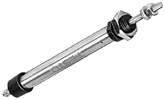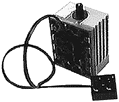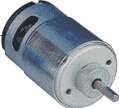![[Jump to Cover]](cover.gif) |
![[Jump to Contents]](contents.gif) |
![[Jump to Introduction]](introduc.gif) |
![[Jump to Concepts]](concepts.gif) |
![[Jump to Realization]](realiza.gif) |
![[Jump to Conclusion]](conclusi.gif) |
![[Jump to Appendix]](appendix.gif) |
3.2 Hardware and Software Analysis
Both the Cricket hardware from the MIT Media Lab and the different types of programming software will be analyzed and discussed thoroughly in separate subsections (3.2.2 and 3.2.3, respectively). But first, a summary is given on the analysis results of the various surrounding systems, namely Festo Pneumatics, Märklin Metall, Lego Technic, various motors, and available options for power supply.3.2.1 Surrounding Systems
- Festo Pneumatics
From the great variety of products Festo (see [c]) offers in the catalogue for industrial users, only a few items can be used in an environment like the Computer Clubhouse Esslingen. Obviously, there is a limitation to the mechanical dimensions of the parts. Although the pneumatic devices should be fully functional and provide a certain power to drive working models, their size should be small enough to be handled by kids.To provide the CCE with a flexible selection of pneumatic devices, a variety of Festo products has been chosen, which seemed to offer all the parts needed to offer a basic understanding of how a pneumatic system works.
 |
Cylinders – as the acting part
in pneumatics – are provided in two different types. On the one hand, there
are very small single-acting cylinders. Single-acting means, they extend
powerfully when supplied with air; when the air supply is shut, a spring
inside the cylinder pulls back the piston.
|
As the spring is
rather weak, this backward movement cannot be used drive a load. The cylinders
chosen for the CCE have the following specifications:
|
|
| On the other hand, there are
also cylinders of a slightly larger type. These are double-acting cylinders,
which means they can be used to drive a load in both directions. Thus,
they have no spring inside but use a second air supply for the backward
movement.
|
|
As discussed later
on, this demands for another and more complicated type of valves. Their
characteristics are as follows:
|
|
| For each type of cylinders, there
is a suitable valve type, namely 3/2-way valves and 5/2-way valves. While
both valves have two positions (idle and active), they differ in the internal
structure and in the number of connectors, as indicated in the name.
|
|
| For an easy understanding,
the two types can be compared to simple electrical switches: The first
one acts like an ordinary switch – the air flow is either enabled or disabled.
The second type acts like a change-over switch – the air is guided either
this way or that way, which is needed for double-acting cylinders connected
with two air tubes.
|
|
 |
Both types are designed as solenoid
valves, requiring a 24V DC voltage for electrical control. In active mode,
each valve consumes about two watts of electrical power. Besides, they
can also be operated manually by using a tiny button. As very little air
throughput is needed for the selected cylinders, the smallest and lightest
version of valves has been chosen, which is only 10mm wide. Under the socket
cover, the valve has a built-in electronic circuit, consisting of two diodes,
a resistor and a LED.
|
| While the LED just
indicates if the valve is active, the two diodes are essential for proper
and save operation: one protects the circuit and the coil from wrong polarity,
the other one is connected in parallel to the coil in order to conduct
the negative voltage peaks induced in the coil in the moment of switching
off.
|
|
| A flow control valve can be used
to regulate a cylinder’s speed. This device is inserted into the air tube
near the cylinder and throttles the air coming out of the cylinder in forward
movement. For air flowing in the opposite direction (i.e., filling the
cylinder for the backward movement), this flow control valve is no obstacle.
|
|
| Thus, you can regulate
the forward and reverse speeds of a cylinder separately, using one flow
control valve on each side. Obviously, this is only possible with double-acting
cylinders; in order to provide the same functionality for single-acting
cylinders, a special device has been created (see "Mechanical
Preparations").
|
|
| For an efficient, yet removable
air connection between valves, cylinders, and the air supply (compressor),
Festo offers plug-in systems, which are very easy to use:
|
|
| You just plug the
end of a tube into a socket – and by pressing a small ring on the socket,
you can remove it as often as you wish. This plug-and-socket system includes
connectors for valves and cylinders as well as different kinds of couplings
and dividers.
The air compressor that Festo provided the CCE with is a rather powerful machine with an air tank and variable pressure. During normal operation of pneumatic-driven models, the compressor needs to work only once in a while, when the pressure in its tank has fallen significantly. - Märklin MetallSince the second half of the 19th century, the Märklin company (see [d]) has been a manufacturer of metal toys and construction kits. The popular Märklin Metall system is marketed as several basic and supplemental kits that may still be expanded with so-called theme kits. While theme kits provide special parts dedicated to certain applications, the basic and supplemental kits available at the CCE contain only very universal elements like beams, angle sections, screws, gear wheels, and axles. |
|
 |
Most parts are fully zinc-plated and painted, while the screws and nuts are made from brass. From an educational point of view, this construction system has several advantages over other toys: |
| As the time you need
to assemble a model is comparatively high due to the screw connections,
it encourages a detailed advance planing of the construction, demanding
for an abstract and analytic way of thinking. The results mostly honor
the efforts that have been summoned up for building the model, as the structures
can be extremely strong and durable. This may create a true sense of achievement
for kids.
The basic parts feature an array of 4mm diameter holes in a half-inch grid, which allows the elements to be connected at various angles and positions. As tools for its construction kits, Märklin includes a screwdriver, two 8mm wrenches, as well as a small allenwrench needed to fix gear wheels on their axles. - Lego TechnicThe basic idea of the well-known Lego (see [e]) bricks – the easy-to-use snapping connection – have been taken over into the compatible Technic system. It is based on an array of round 5mm buttons on the top of a brick that are pressed into their counterparts on the bottom of another one. The main differences to the plain Lego bricks are additional holes as well as a great variety of new parts that are useful for technical applications. |
|
 |
While standard Lego bricks could
only be assembled by putting one brick onto another, a bar of Lego Technic
can also be attached to the long side of another one with the help of plug
bolts that snap into the holes in the bars. This is just one example of
how much more flexible this system is, compared to the plain Lego bricks.
|
| However, the fact
that makes Lego Technic interesting for the use in Computer Clubhouses
is the system’s ability to allow even younger and inexperienced kids to
build up their own working models that may then be powered by motors. The
reasons for this are the simplicity of the connection principle as well
as the availability of pre-built elements of complex structure, e.g. a
differential gearbox or steering shafts for an automobile.
On the other hand, Lego has two severe shortcomings, when compared to the Märklin system. They have their roots in the plastic material and the snap joints: The models built with Lego are much less durable and weaker in the application. This means e.g., a Lego crane is not capable of carrying heavy loads because it will either bend too much, or even break apart at the snap joints. Nevertheless, Lego Technic is the kids’ favorite system for the quick assembly of a model they have in mind. - MotorsTo power the Märklin or Lego models, three different motors are available at the CCE. There are two types of Lego motors – micro motors and standard motors – and an inexpensive type of larger standard motors which can be found at electronics stores. The latter are in fact of the same size as those marketed by Märklin, which is why the original Märklin motors will not be described here. |
|
 |
The Lego micro motor is the only
one that can be used with the MIT Cricket modules. It is less than one
cubic inch in size and has a built-in gearbox. At 9V, the shaft of this
tiny motor reaches about 30 turns per minute when idling. Even when stalled
at 9V (which is its nominal voltage), the current consumption stays below
80mA, which equals about 0.7W of input power.
|
| This motor is very
useful where slow motion is needed and energy is valuable, e.g. as
a driving unit in small battery- |
|
 |
The standard Lego motor, however,
is much more powerful and is also designed for 9V operation. Just like
the micro motor, it has a Lego axle shaft, but there is no built-in gearbox.
The shaft turns at high speed, and this motor’s idle current equals the
stalled current of the micro motor!
|
| Because of its maximum
current of 680mA when stalled at 9V, the Lego standard motor cannot be
driven by the Cricket’s motor output, which allows only 150mA.
The overall advantages of this motor – high power and speed, combined with its compact brick- |
|
 |
The largest motor available at
the CCE is a high-power motor of the Johnson brand, which has a nominal
voltage range of 3..15V. Designed as a slow motor with a five-part rotor,
it has an idle speed of 5500rpm at 500mA (at 6V). At the point of highest
efficiency, it uses about 2.8A (at 6V). The ratings at 9V will be significantly
higher.
|
- Power supplies
The standard 9V batteries for which the Crickets have been designed provide an electrical capacity of about 120mAh. This applies to the popular NiCd batteries, while the latest NiMH types can store up to 20% more energy. When attached to a Cricket running two of the tiny Lego micro motors, a battery of this kind will last less than two hours, where the power that sensor devices and the Cricket itself will consume has not yet been taken into consideration.As standard batteries have a recharging time of about 14 hours, a large amount of batteries and chargers would be needed in order to supply a couple of Crickets with electricity for several hours.
While a stabilized power supply which can deliver 0..30V DC and up to 3A is available at the CCE, this is not suitable to be operated by the kids: the variable voltage involves the risk that the Crickets may easily be destroyed. In addition to this, most Cricket applications will probably require a mobile power supply.